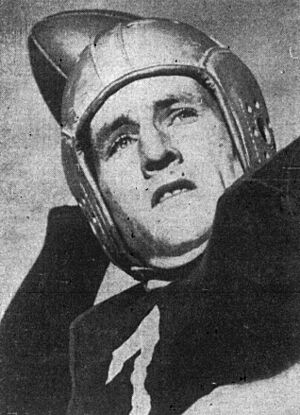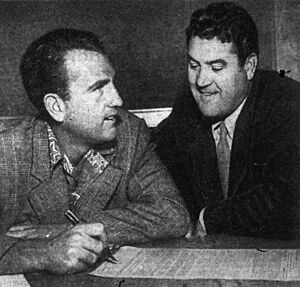Bob Waterfield facts for kids

Waterfield c. 1947
|
|||||||||||||||||
| No. 7 | |||||||||||||||||
|---|---|---|---|---|---|---|---|---|---|---|---|---|---|---|---|---|---|
| Position: | Quarterback Safety Kicker Punter |
||||||||||||||||
| Personal information | |||||||||||||||||
| Born: | July 26, 1920 Elmira, New York, U.S. |
||||||||||||||||
| Died: | March 25, 1983 (aged 62) Burbank, California, U.S. |
||||||||||||||||
| Height: | 6 ft 1 in (1.85 m) | ||||||||||||||||
| Weight: | 200 lb (91 kg) | ||||||||||||||||
| Career information | |||||||||||||||||
| High school: | Van Nuys (Los Angeles, California) |
||||||||||||||||
| College: | UCLA (1941–1942, 1944) | ||||||||||||||||
| NFL Draft: | 1944 / Round: 5 / Pick: 42 | ||||||||||||||||
| Career history | |||||||||||||||||
| As player: | |||||||||||||||||
|
|||||||||||||||||
| As coach: | |||||||||||||||||
|
|||||||||||||||||
| Career highlights and awards | |||||||||||||||||
|
|||||||||||||||||
| Career NFL statistics | |||||||||||||||||
|
|||||||||||||||||
| Head coaching record | |||||||||||||||||
| Career: | 9–24–1 (.279) | ||||||||||||||||
| Player stats at PFR | |||||||||||||||||
| Coaching stats at PFR | |||||||||||||||||
|
Pro Football Hall of Fame
|
|||||||||||||||||
Robert "Bob" Waterfield (born July 26, 1920, died March 25, 1983) was an amazing American football player and coach. He played in the National Football League (NFL) for eight seasons. Bob was mostly a quarterback, but he was also a safety, kicker, punter, and sometimes a return specialist. He played for the Cleveland and later the Los Angeles Rams.
Before joining the pros, he played college football for the UCLA Bruins. Bob Waterfield was so good that he was added to the Pro Football Hall of Fame in 1965. The Rams even retired his jersey number 7 in 1952 to honor him. Besides football, he also worked in movies as an actor and producer!
Bob was born in Elmira, New York. His family moved to Los Angeles when he was a baby. In college, he helped UCLA win a championship and reach their first Rose Bowl in 1942.
From 1945 to 1952, he led the Rams to two NFL championships, one in 1945 and another in 1951. He was named the NFL's Most Valuable Player (MVP) in 1945. Bob was known for his strong arm, great punts, and accurate kicks. He set NFL records for extra points and field goals during his career.
Later in his life, Bob Waterfield worked as a coach for the Rams. He was the head coach from 1960 to 1962. He was married to famous movie actress Jane Russell for many years.
Contents
Bob Waterfield's Early Life
Bob Waterfield was born in Elmira, New York, in 1920. His parents were Staton and Frances Waterfield. Around 1921, his family moved to Los Angeles. They settled in Van Nuys, which is in the San Fernando Valley.
When Bob was nine years old, his father passed away. His dad owned a moving and storage company. Bob went to Van Nuys High School. He was a star football player there.
College Football and Military Service
Bob Waterfield attended the University of California, Los Angeles (UCLA). He played college football for the UCLA Bruins football team in 1941, 1942, and 1944.
In 1942, he was a top passer in the Pacific Coast Conference. He threw for over 1,000 yards and 12 touchdowns. He also averaged 40 yards per punt. Bob played a lot, being on the field for 557 out of 600 minutes in 10 games. He led the 1942 Bruins to win the Pacific Coast Conference championship. He was chosen as the best quarterback on the 1942 All-Pacific Coast football team.
In the 1943 Rose Bowl, UCLA played against Georgia. The game was scoreless until the fourth quarter. Georgia won 9–0 after a blocked punt and a touchdown.
In April 1943, Bob married Jane Russell. She was his high school sweetheart. A couple of weeks later, he joined the United States Army. He became a lieutenant and played football for the 176th Infantry Spirits team.
In June 1944, Bob was honorably discharged from the Army. This was due to a knee injury. He returned to UCLA and played for the 1944 UCLA football team. He was named a second-team player on the 1944 All-Pacific Coast football team.
On January 1, 1945, Bob played in the East–West Shrine Game. He helped his team win with his amazing passing and kicking. He had punts of 87, 75, and 59 yards! He even caught the winning touchdown pass. A sports writer called him "one of the finest kickers and passers in Coast history."
Playing for the Rams
The Cleveland Rams picked Bob Waterfield in the 1944 NFL draft. He signed with them in June 1945.
1945: Rookie of the Year
As a rookie, Bob became the starting quarterback. He led the 1945 Rams team to an NFL championship! They had a great 9–1 record. Bob led the NFL in total offense and touchdown passes. He also played defense and intercepted 6 passes.
In the 1945 NFL Championship Game, the Rams beat the Washington Redskins 15–14. Bob was key to their win, throwing two touchdown passes. After the season, he was named the NFL's Most Valuable Player (MVP). He was also chosen as the best quarterback on the 1945 All-Pro Team.
1946: Moving to Los Angeles
In January 1946, the Rams moved from Cleveland to Los Angeles. In their first season in Los Angeles, the Rams finished second in their division. Bob showed he was a true all-around player. He led the NFL in pass attempts, completions, and touchdown passes. He also scored the second-most points in the league. He was perfect on extra points (37 for 37!). He also had a great punting average. He was again chosen as the first-team quarterback on the 1946 All-Pro Team.
1947 and 1948 Seasons
In 1947, the Rams didn't do as well. But Bob still led the NFL with seven field goals. He also had an 86-yard punt, the longest in the league that year. In 1948, he had another long punt, 88 yards! He also played defense and intercepted 20 passes in his first four NFL seasons.
1949: Back to the Top
Bob and the Rams had a great year in 1949. They won the NFL's Western Division championship. They made it to the 1949 NFL Championship Game but lost to the Philadelphia Eagles. Bob had career highs in completed passes and passing yards. He was chosen as the first-team All-Pro quarterback for the third time.
1950: Sharing the Field
In 1950, another great quarterback, Norm Van Brocklin, joined the Rams. Bob and Norm each started six games that season. Bob had the best completion percentage in the NFL that year. The 1950 Rams won their conference championship. They beat the Chicago Bears in a playoff game. Bob came off the bench in that game and threw three touchdown passes! He also kicked a field goal and extra points. The Rams then lost a close game to the Cleveland Browns in the 1950 NFL Championship Game.
1951: Another Championship
After the 1950 season, Bob Waterfield even tried acting! He was in a movie called "Jungle Manhunt."
In the fall of 1951, Bob was the main starting quarterback again. He led the 1951 Rams to another NFL championship! He led the NFL in passer rating and yards per completion. He also made 13 field goals and scored 98 points. He threw a 91-yard touchdown pass, the longest in the NFL that year. At the end of the season, he played in his second Pro Bowl.
1952: Retirement
In 1952, Bob shared the quarterback job with Norm Van Brocklin again. Each started six games. On December 1, 1952, Bob announced he would retire after the season. The Rams honored him with "Bob Waterfield Day" at their last home game. They retired his No. 7 jersey.
The Rams tied for the best record in their conference that year. In the playoffs, Bob played and kicked three extra points. But the Rams lost to the Detroit Lions.
Bob Waterfield's Career Highlights
When he retired in 1952, Bob Waterfield held several NFL records. He had 315 extra points and 60 field goals. He also set a single-season record with 54 extra points in 1950. He tied a record with nine extra points in one game.
During his eight seasons with the Rams, he led the team to two NFL championships. He also led them to four division championships. He averaged 42.4 yards as a punter. He completed 814 passes for 11,849 yards and 97 touchdowns.
Movie Producer and Football Coach

In 1954, Bob Waterfield started a movie production company with his wife, Jane Russell. It was called Russ-Field Productions. They produced movies like Run for the Sun (1956) and The King and Four Queens (1956).
Bob also worked as a kicking coach for the Rams in 1954 and 1955. In 1957, he was an assistant coach for the Toronto Argonauts in Canada.
In 1958, Bob returned to the NFL as an assistant coach for the Rams. He helped train the team's quarterbacks.
In January 1960, Bob Waterfield became the head coach of the Rams. He coached for three seasons. His overall record as head coach was 9 wins, 24 losses, and 1 tie. After coaching, he worked as a team scout and a rancher.
Awards and Honors
Bob Waterfield received many awards for his amazing football career:
- He was chosen as the best quarterback on the 1945, 1946, and 1949 All-Pro Teams.
- In 1945, he won the Joe F. Carr Trophy as the NFL's Most Valuable Player.
- He played in the Pro Bowl twice (in 1950 and 1951).
- In 1952, the Los Angeles Rams retired his jersey No. 7.
- In 1965, he was elected to the Pro Football Hall of Fame.
- In 1969, he was named a quarterback on the NFL 1940s All-Decade Team.
Family Life
On April 24, 1943, Bob Waterfield married actress Jane Russell. They had been sweethearts since high school. They adopted three children together: Thomas, Tracy, and Robert John. They later divorced in 1968. Bob married Janet Ann Green in 1970.
Bob Waterfield passed away on March 25, 1983, at age 62, after a long illness.
Head Coaching Record
| Team | Year | Regular Season | Post Season | |||||||||||||||||
|---|---|---|---|---|---|---|---|---|---|---|---|---|---|---|---|---|---|---|---|---|
| Won | Lost | Ties | Win % | Finish | Won | Lost | Win % | Result | ||||||||||||
| Los Angeles | 1960 | 4 | 7 | 1 | .375 | 6th in NFL West | – | – | – | – | ||||||||||
| Los Angeles | 1961 | 4 | 10 | 0 | .286 | 6th in NFL West | – | – | – | – | ||||||||||
| Los Angeles | 1962 | 1 | 7 | 0 | .125 | 7th in NFL West | – | – | – | – | ||||||||||
| Los Angeles Total | 9 | 24 | 1 | .279 | – | – | – | – | ||||||||||||



